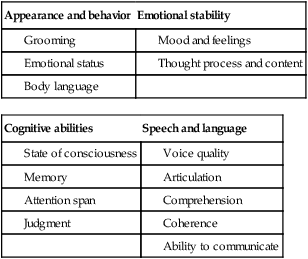When concerned about any of the patient’s responses or behaviors, ask a family member if the patient has had any problems with the following: remembering important appointments or events, paying bills, shopping independently for food or clothing, taking medication, getting lost while walking or driving, making decisions about daily life, or asking the same thing again and again (Maslow and Mezey, 2008). Ask patient to remember and immediately repeat three unrelated words (e.g., red, plate, and milk). Ask patient to draw a clock face with numbers, then place hands pointing to the time you specify. Allow 3 minutes. Ask the patient to repeat the three words. Score 1 point for each word recalled. Use this examination to quantify cognitive function or document changes. See http://www.minimental.com/ to access the full tool. Use this test to evaluate mental status as a whole (motivation, alertness, concentration, short-term memory, problem solving). Ask patient to name 10 items in each of 4 groups: fruit, animals, colors, towns, or cities. Give each item 1 point for a maximum of 40 points (Chopard et al, 2007). Ask patient to describe analogies: first simple, then more complex • What is similar about peaches and lemons, oceans and lakes, trumpet and flute? • An engine is to an airplane as an oar is to a _____? • What is different about a magazine and a telephone book, or a bush and a tree?
Mental Status
Examination
Appearance and behavior
Emotional stability
Cognitive abilities
Speech and language

Technique
Findings
Mental Status and Speech Patterns
Observe physical appearance and behavior
UNEXPECTED: Poor hygiene; lack of concern with appearance; or inappropriate dress for season, gender, or occasion in previously well-groomed patient.
EXPECTED: Usually friendly and cooperative; expresses concern appropriate for emotional content of topics discussed.
UNEXPECTED: Behavior conveys carelessness, apathy, loss of sympathetic reactions, unusual docility, rage reactions, agitation, or excessive irritability.
EXPECTED: Erect posture and eye contact (if culturally appropriate).
UNEXPECTED: Slumped posture, lack of facial expression, excessively energetic movements, or constantly watchful eyes.
EXPECTED: Oriented to person, place, and time; appropriate responses to questions and environmental stimuli.
UNEXPECTED: Disoriented to time, place, or person. Verbal response is confused, incoherent, or inappropriate, or there is no verbal response.
Investigate cognitive abilities
EXPECTED: All three words are remembered, and the clock face has all numbers in proper position and hands pointing to the specified time.
UNEXPECTED: A score of ≤2 may indicate dementia.
Score 2 points when all numbers of the clock face are near the rim, in correct sequence, and hands point to the specified time. Total of 5 points (Doerflinger, 2007).
EXPECTED: Score of 26-30. Score of 21-25 is borderline.
UNEXPECTED: Score ≤20 is associated with dementia.
EXPECTED: Able to categorize, count, remember items listed. Score of ≥25 points.
UNEXPECTED: Score <15 points. Check for mental changes or cultural, educational, or social factors when score is 15-24.
![]()
Stay updated, free articles. Join our Telegram channel

Full access? Get Clinical Tree

 Get Clinical Tree app for offline access
Get Clinical Tree app for offline access

Mental Status
Get Clinical Tree app for offline access